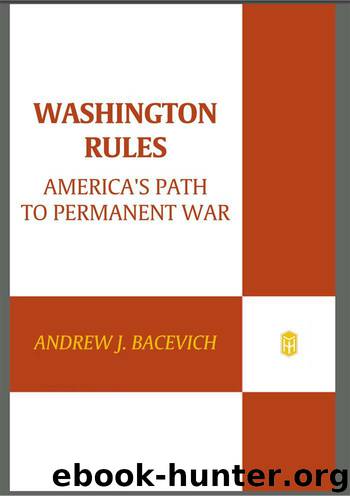Washington Rules by Bacevich Andrew

Author:Bacevich, Andrew [Bacevich, Andrew]
Language: eng
Format: mobi, epub
ISBN: 9781429943260
4
RECONSTITUTING THE TRINITY
By the 1980s, the American penchant for intervention was already showing signs of robust recovery, with defenders of the Washington consensus enjoying similar success in reshaping the instruments of global power projection and fending off calls to scale back the U.S. global presence. By the end of the century, the whole sacred trinity was back, bigger and better than ever.
The Soviet Union had done its best to help, as had adherents of radical Islam. The Soviet invasion of Afghanistan in 1979, along with Soviet military and economic assistance to leftist revolutionaries in Central America during the 1980s, fostered the impression, fueled by hawks in the United States, that the Red Menace was reaching new heights. The overthrow of the Shah of Iran, also in 1979, leading to the creation of the Islamic Republic of Iran and the humiliating capture of American diplomats by radical Iranian students, supposedly demonstrated the consequences of giving the impression that the United States was becoming weak and pusillanimous. Iranians saw the ensuing 444-day hostage crisis as just retribution—payback for Washington’s incessant meddling in Iranian affairs. Americans chose to see it as an unwarranted assault on innocent representatives of a well-meaning nation.
To the extent that Vietnam had inspired any inclination to shrink the Pentagon’s global “footprint,” that inclination quickly ebbed and, by the end of the 1970s, had all but disappeared. Over the course of the next two decades, what occurred was not retrenchment but reconfiguration. U.S. troops did withdraw from Southeast Asia (though retaining a foothold in Thailand) and Taiwan (part of the price paid for Richard Nixon’s opening to China). A nearly century-long U.S. military presence in the Philippines also ended, felled by Filipino anticolonialism and the 1991 eruption of Mount Pinatubo, which wrecked Clark Air Force Base and the American naval station at Subic Bay. Yet U.S. forces remained in Japan, operating a network of bases in both the home islands and Okinawa.
Running for president in 1976, Jimmy Carter vowed to remove American troops from the Korean peninsula, an effort that failed in the face of concerted military and congressional opposition. In the meantime, the Pentagon gained access to Singapore, improved its facilities on the Pacific island of Guam, and began developing a major new base in the Indian Ocean on the British-owned island of Diego Garcia—a project that entailed expelling the island’s inhabitants.1
As the Soviet threat subsided and then disappeared, so too did the traditional rationale for this continuing presence. So the Pentagon devised a new rationale. Rather than defending key allies from external attack, U.S. forces abroad were now needed to facilitate the emergence of a new world order. In any case, they had to stay.
The Pentagon’s post–Cold War mission, explained Secretary of Defense William S. Cohen in 1998, was “to shape the environment,” creating conditions conducive to international stability and economic growth. “How do we do that? We have to be forward deployed.” Although other elements of national policy might change, Cohen insisted, the presence of U.S. troops on bases worldwide remained absolutely essential.
Download
This site does not store any files on its server. We only index and link to content provided by other sites. Please contact the content providers to delete copyright contents if any and email us, we'll remove relevant links or contents immediately.
| Arms Control | Diplomacy |
| Security | Trades & Tariffs |
| Treaties | African |
| Asian | Australian & Oceanian |
| Canadian | Caribbean & Latin American |
| European | Middle Eastern |
| Russian & Former Soviet Union |
The Secret History by Donna Tartt(18951)
The Social Justice Warrior Handbook by Lisa De Pasquale(12170)
Thirteen Reasons Why by Jay Asher(8848)
This Is How You Lose Her by Junot Diaz(6837)
Weapons of Math Destruction by Cathy O'Neil(6220)
Zero to One by Peter Thiel(5736)
Beartown by Fredrik Backman(5682)
The Myth of the Strong Leader by Archie Brown(5461)
The Fire Next Time by James Baldwin(5386)
How Democracies Die by Steven Levitsky & Daniel Ziblatt(5175)
Promise Me, Dad by Joe Biden(5117)
Stone's Rules by Roger Stone(5053)
A Higher Loyalty: Truth, Lies, and Leadership by James Comey(4909)
100 Deadly Skills by Clint Emerson(4882)
Rise and Kill First by Ronen Bergman(4741)
Secrecy World by Jake Bernstein(4703)
The David Icke Guide to the Global Conspiracy (and how to end it) by David Icke(4658)
The Farm by Tom Rob Smith(4468)
The Doomsday Machine by Daniel Ellsberg(4452)
